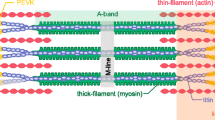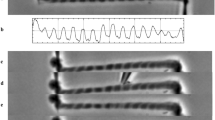Abstract
The purpose of this study was to gain further insight into passive force enhancement by testing whether passive force enhancement occurs in single myofibrils. Myofibrils (n = 6) isolated from rabbit psoas muscle were fixed at a sarcomere length of 2.4 μm, and then stretched passively and actively to a sarcomere length of 3.4 μm. Passive force after deactivation of the myofibrils was increased after active compared to passive stretching. Therefore, passive force enhancement, previously observed in muscle and fiber preparations, also occurs in single myofibrils. Passive force enhancement in myofibrils ranged from 86 to 145% of the steady-state force observed after passive stretch. Because titin is the main source of passive force in myofibrils, we propose that titin might be responsible for passive force enhancement observed in myofibrils. We propose that this might occur through an increase in stiffness when calcium concentration increases upon activation.

Similar content being viewed by others
References
Abbott BC, Aubert XM (1952) The force exerted by active striated muscle during and after change of length. J Physiol 117:77–86
Bartoo ML, Linke WA, Pollack GH (1997) Basis of passive tension and stiffness in isolated rabbit myofibrils. Am J Physiol 273:C266–C276
Cazorla O, Freiburg A, Helmes M, Centner T, McNabb M, Wu Y, Trombitas K, Labeit S, Granzier H (2000) Differential expression of cardiac titin isoforms and modulation of cellular stiffness. Circ Res 86:59–67
Edman KA, Elzinga G, Noble MI (1982) Residual force enhancement after stretch of contracting frog single muscle fibers. J Gen Physiol 80:769–784
Freiburg A, Trombitas K, Hell W, Cazorla O, Fougerousse F, Centner T, Kolmerer B, Witt C, Beckmann JS, Gregorio CC, Granzier H, Labeit S (2000) Series of exon-skipping events in the elastic spring region of titin as the structural basis for myofibrillar elastic diversity. Circ Res 86:1114–1121
Gordon AM, Huxley AF, Julian FJ (1966) The variation in isometric tension with sarcomere length in vertebrate muscle fibres. J Physiol 184:170–192
Granzier H, Helmes M, Cazorla O, McNabb M, Labeit D, Wu Y, Yamasaki R, Redkar A, Kellermayer M, Labeit S, Trombitas K (2000) Mechanical properties of titin isoforms. Adv Exp Med Biol 481:283–300
Granzier HL, Irving TC (1995) Passive tension in cardiac muscle: contribution of collagen, titin, microtubules, and intermediate filaments. Biophys J 68:1027–1044
Granzier HL, Wang K (1993) Passive tension and stiffness of vertebrate skeletal and insect flight muscles: the contribution of weak cross-bridges and elastic filaments. Biophys J 65:2141–2159
Herzog W, Leonard TR (2002) Force enhancement following stretching of skeletal muscle: a new mechanism. J Exp Biol 205:1275–1283
Herzog W, Leonard TR (2000) The history dependence of force production in mammalian skeletal muscle following stretch-shortening and shortening-stretch cycles. J Biomech 33:531–542
Herzog W, Leonard TR, Renaud JM, Wallace J, Chaki G, Bornemisza S (1992) Force-length properties and functional demands of cat gastrocnemius, soleus and plantaris muscles. J Biomech 25:1329–1335
Herzog W, Schachar R, Leonard TR (2003) Characterization of the passive component of force enhancement following active stretching of skeletal muscle. J Exp Biol 206:3635–3643
Higuchi H, Umazume Y (1985) Localization of the parallel elastic components in frog skinned muscle fibers studied by the dissociation of the A- and I-bands. Biophys J 48:137–147
Horowits R (1992) Passive force generation and titin isoforms in mammalian skeletal muscle. Biophys J 61:392–398
Horowits R, Kempner ES, Bisher ME, Podolsky RJ (1986) A physiological role for titin and nebulin in skeletal muscle. Nature 323:160–164
Kovanen V, Suominen H, Heikkinen E (1984) Mechanical properties of fast and slow skeletal muscle with special reference to collagen and endurance training. J Biomech 17:725–735
Labeit D, Watanabe K, Witt C, Fujita H, Wu Y, Lahmers S, Funck T, Labeit S, Granzier H (2003) Calcium-dependent molecular spring elements in the giant protein titin. Proc Natl Acad Sci USA 100:13716–13721
Lee EJ, Joumaa V, Herzog W (2007) New insights into the passive force enhancement in skeletal muscles. J Biomech 40:719–727
Lee HD, Herzog W (2002) Force enhancement following muscle stretch of electrically stimulated and voluntarily activated human adductor pollicis. J Physiol 545:321–330
Linke WA, Ivemeyer M, Olivieri N, Kolmerer B, Ruegg JC, Labeit S (1996) Towards a molecular understanding of the elasticity of titin. J Mol Biol 261:62–71
Linke WA, Popov VI, Pollack GH (1994) Passive and active tension in single cardiac myofibrils. Biophys J 67:782–792
Morgan DL, Whitehead NP, Wise AK, Gregory JE, Proske U (2000) Tension changes in the cat soleus muscle following slow stretch or shortening of the contracting muscle. J Physiol 522(Pt 3):503–513
Opitz CA, Kulke M, Leake MC, Neagoe C, Hinssen H, Hajjar RJ, Linke WA (2003) Damped elastic recoil of the titin spring in myofibrils of human myocardium. Proc Natl Acad Sci USA 100:12688–12693
Rapoport SI (1973) The anisotropic elastic properties of the sarcolemma of the frog semitendinosus muscle fiber. Biophys J 13:14–36
Rassier DE, Herzog W (2004) Active force inhibition and stretch-induced force enhancement in frog muscle treated with BDM. J Appl Physiol 97:1395–1400
Rassier DE, Herzog W, Pollack GH (2003) Dynamics of individual sarcomeres during and after stretch in activated single myofibrils. Proc Biol Sci 270:1735–1740
Rassier DE, Herzog W, Wakeling J, Syme DA (2003) Stretch-induced, steady-state force enhancement in single skeletal muscle fibers exceeds the isometric force at optimum fiber length. J Biomech 36:1309–1316
Rassier DE, Lee EJ, Herzog W (2005) Modulation of passive force in single skeletal muscle fibres. Biol Lett 1:342–345
Tatsumi R, Maeda K, Hattori A, Takahashi K (2001) Calcium binding to an elastic portion of connectin/titin filaments. J Muscle Res Cell Motil 22:149–162
Wang K, McCarter R, Wright J, Beverly J, Ramirez-Mitchell R (1991) Regulation of skeletal muscle stiffness and elasticity by titin isoforms: a test of the segmental extension model of resting tension. Proc Natl Acad Sci USA 88:7101–7105
Acknowledgment
The authors would like to thank H. M. Brattberg and A. Jinha for their technical assistance. The financial support of Natural Sciences and Engineering Research Council of Canada (NSERC), the Canadian Institutes of Health Research (CIHR), and the Canada Research Chair Program is greatly acknowledged.
The nanolevers used in this study were constructed at the Cornell NanoScale Facility, which is supported by the National Science Foundation (grant ECS 03-35765).
Author information
Authors and Affiliations
Corresponding author
Rights and permissions
About this article
Cite this article
Joumaa, V., Rassier, D.E., Leonard, T.R. et al. Passive force enhancement in single myofibrils. Pflugers Arch - Eur J Physiol 455, 367–371 (2007). https://doi.org/10.1007/s00424-007-0287-2
Received:
Accepted:
Published:
Issue Date:
DOI: https://doi.org/10.1007/s00424-007-0287-2




